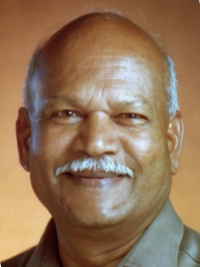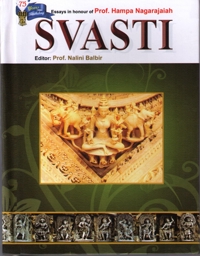The central part of this paper makes use of material collected in the entry No. 1290 of Nalini Balbir, Kanubhai V. Sheth, Kalpana K. Sheth, C.B. Tripathi, Catalogue of the Jain Manuscripts of the British Library, London: The British Library, The Institute of Jainology, 2006, 3 volumes + 1 CD, where items belonging to the Victoria and Albert Museum and the British Museum are also included.
9
A 17th century Digambara Yantra kept at the British Museum
Jina images are the best known medium of meditation and worship, at least for those Jains who recognize the value of an image. But there are other objects of meditation and worship too. Among the most prominent ones are the sacred diagrams (yantras) associated with sacred or magic formulas (mantras) which have produced interesting and valuable artifacts. One of the first studies of Jaina iconography published outside India which has given them the right place they deserve is that by Jain and Fischer (1978) where a fairly wide range of representations from both Śvetāmbara and Digambara milieus is offered to the reader,[1] aptly described and placed within the religious context where the objects belong and are used. The tradition of large painted diagrams from western India on paper or cloth, mostly from Śvetāmbara origin, which are occasionally seen in museum collections in India and outside, has been discussed by several scholars, and most recently by Cort (2009) who, on the other hand, is concerned with the rituals associated with yantras on the basis of what he has seen among Digambaras of Jaipur, thus in a contemporary setting. In this paper my aim is to bring a modest contribution to this vast area of research, which is still in need of exploration, through the examination of a single item from a Digambara surrounding.
Digambara metal yantras
Technically, the term yantra is normally restricted to designate objects of a size and weight which allow them to be easily carried (and, therefore, unfortunately, stolen too) and is different from a maṇḍala.[2] These objects are mostly discs made of metal, mostly copper, which are incised. The “culture of yantras” (Cort 2009: 150) is specially lively among Digambaras. The fundamental form of the Jain yantra (also recognized by Śvetāmbaras and well-represented in their literary and iconographic tradition) is the siddhacakra connected with the pañcanamaskāra mantra where the Five Entities are shown in a lotus with four petals attached to a circle.[3] Even more common is the form where the spaces between the petals are occupied by the four basic principles: right knowledge, right faith, right conduct and right penance. Among the Digambaras this form is known as Navadevatā. One of the most famous instances is the Navadevatā yantra from 1858 CE kept at the Jain Matha, Shravanabelgola. The Tamil inscription at the back of the image is in Tamil and Grantha characters:
“On the full-moon day of the bright fortnight of Āshāḍha, in the year named Kāḷayukta which comes after the lapse of 51 years from Prabhava, the 1780th year of the Śālivāhana era, for daily worship in the maṭha at Belguḷa, this image of the Pañcha-Paramēshṭhis was presented by Perumāḷ-śrāvaka of Tañja-nagaram. May uninterrupted prosperity increase”.[4]
Such is the basic form, but Digambara yantras are of many different types and variants are almost infinite.
For example, a contemporary one (reproduced in Cort 2009: 149 fig. 9.11 and purchased by him in 2008) is basically a Siddhacakra/Navadevatā, with 9 compartments, each having the sacred syllable hrīṃ. The inscribed text has the formula ṇamo arihantāṇaṃ repeated nine times and no other part of the Namaskāra mantra. In the circle around the central hrīṃ it has all the vowels of the modern Nāgarī/Hindi alphabet in succession (a, ā, i, ī, u, ū, ṛ, ṝ, ḷ, ḹ, e, ai, o, au, aṃ, aḥ) while the full alphabet is unfolded in groups of letters on the eight petals of the lotus: 1) vowels again, 2) guttural consonants, 3) palatals, 4) cerebrals, 5) dentals, 6) labials, 7) semi-consonants (ya, ra, la, va), 8) sibilants (śa, ṣa, sa) and ha. It is well-known that akṣaras can be considered as containing the essence of teaching. In the Jain context, oṃ is interpreted as being made of a-a-a-u-m, which is the acronym referring to the Five Entities. One can also refer conveniently to the beginning of the Ṛṣimaṇḍalastotra which reads: “Between the first letter ‘a’ and the last letter ‘h’ come all the letters. By adding a dot and an ‘ṛ’-sign to the last letter which is ‘sound’ and is like a flame the word ‘arhaṃ’ is made”.[5]
Line drawings of 48 Digambara yantras are conveniently reproduced in the Jainendra Siddhānta Kośa.[6] They are inscribed in a number of ways, combining magic or sacred syllables, such as hrīṃ or others, and homage formulas with fundamental concepts or beings of the Jain doctrine. The Five Entities (pancaparameṣṭhins), the Three Jewels (ratnatraya) and the 24 Jinas are among the basic ones. But a lot more sophistication in the conceptual lists is present in several yantras, which are made of several successive concentric circles and result into a complex picture. Their shape is an obvious reminder of the representation of the Jain universe and its succession of continents and oceans.
Such brass/copper yantras are found in large numbers in Digambara temples all over India, from South to North. They are kept in large numbers whether in Rajasthan, Madhya Pradesh or Rajasthan.[7] In Tamil Nadu, they are often seen displayed side by side with images of Jinas, of goddesses such as Padmāvatī or of metal śrutaskandhas, which symbolize the Scriptures.[8] All these objects together form a sometimes crowded group placed on a platform on each side of the small corridor leading to the cella (Plate 9.1). Since yantras are objects of a size and a weight which make them easy to carry, they can serve various religious purposes. They are used as seats on which a Jina image will be placed, or they are placed erect in front of Jina images or pādukās, for instance (Plate 9.2). To some extent, they are inseparable from the Jina images themselves and can be viewed as supplementing them. On the other hand, for being used a yantra is consecrated. If it is so, it is worshipped daily by ablution (abhiṣeka; Cort 2009: 150). Hence a yantra has a status similar to that of an image (Plate 9.3).
In the same way as there are Jina images with inscriptions testifying to the fact that they were commissioned and produced in certain places, at certain times by certain persons, in the same way there is ample evidence showing that yantras were commissioned by lay families at the instigation of Digambara religious teachers (bhaṭṭāraka). Out of 766 records reproduced by Johrapurkar in his invaluable book Bhaṭṭāraka Sampradāya, 37 relate to various types of yantras which were commissioned by laypeople at the instigation of different bhaṭṭārakas between the middle of the 15th century and the 19th century in northern and central India:
Daśalakṣaṇa yantra: Nos. 215, 266, 322, 595, 609 (during the reign of Shah Jahan, at Fatehpur), 615
Ṣoḍaśakāraṇa yantra: Nos. 71, 128, 216, 273, 320, 531, 537, 539
Ratnatraya yantra: Nos. 685, 744, 746
Darśana yantra: Nos. 207, 261, 314, 321
Jñāna yantra: Nos. 64, 319, 500
Samyakcāritra yantra: Nos. 210, 310, 352, 540
Ṛṣimaṇḍala yantra: Nos. 183, 611
Navagraha: No 765
Jala yantra: No. 24
Ananta yantra: No. 33
Kalikuṇḍa yantra: No. 398
Unspecified: Nos. 209, 532, 563.Yantras are used for protection, for pacification of evil powers, for attracting or submitting people to one’s own will, or for worldly benefits of all kinds. In the Jain context they are also credited with the power to annihilate karmas.[9] This is one reason why the text incised on these discs is often rather technical and gives an important place to doctrinal terms and categories, as the designations of the yantras themselves show. A Daśalakṣaṇa yantra refers to a standard list of ten main qualities (see below). A Ṣoḍaśakāraṇa yantra lists the 16 factors or conditions, which result into one’s rebirth as a future Jina, etc. The Digambara yantras are not used alone. They are associated with recitations and pūjās having the same names and contents. A handbook such as the Jñānapīṭha Pūjāñjali where common Digambara liturgies are conveniently collected shows how verse compositions, by famous poets such as Raïdhū (15th century) or unknown authors, on the 10 characteristics, the 16 factors, the 3 jewels, etc., are to be supplemented by mantras in the ritual performance. These mantras are what we read on the incised discs. The corresponding yantra is thus the material form, which encapsulates these components.
The British Museum Digambara yantra
The object under reference in this paper is a circular copper yantra of 39,5 x 39,5 cm., dated Vikrama Samvat 1688 (= 1631 CE). Hence it is comparatively large. It now belongs to the British Museum (shelfmark: OA 1880-4057). “1880” in the shelfmark of the object refers to the year of acquisition. Unfortunately, however, nothing more is known about the provenance and the way the object entered the British Museum, either directly from India or through the India Museum.[10]
The yantra is available for display to the viewers in Room 33 of the British Museum, case 8 where 8 other yantras (non-Jain) are nicely presented. The Digambara object is found among the highlighted objects for India on the Museum website, where an image and a short description are available on line (Plate 9.4).[11]
The mantras
This yantra is heavily inscribed and the text is often crowded. It is incised everywhere, from the centre to the very edge. The script is Devanāgarī. The language is Sanskrit, with some inaccuracies or spelling mistakes: for instance, -aya instead of -āya in the ending of the dative, single consonant when a double consonant is required (e.g., paṭa for paṭṭa), etc. Occasional orthographic features reflect the pronunciation of the Hindi (or another North Indian language) spoken by the person who incised the yantra, whoever he may be (e.g. –ja- for –ya- in Kundakundācārje).
The text is transcribed here as it is, without any attempt at corrections, most of which are obvious anyway.
Text
1) Centre: inscribed triangle inserted within a circle (Plate 9.5).
- In the middle is the syllable hrīṃ in characters larger than the rest.
- In the first angle: oṃ hrīṃ samyag-darśanāya namaḥ.
- In the second angle: oṃ hrīṃ samyag-jnānāya namaḥ.
- In the third angle: oṃ hrīṃ samyag-cāritrāya namaḥ.
2) Around the central triangle is a circle arranged in three compartments, each of which is divided into two parts.
a) oṃ hrīṃ astitva-dharmāya namaḥ ǀ oṃ hrīṃ vastutva-dharmāya namaḥ
b) oṃ hrīṃ prameyatva-dharmāya namaḥ. ǀ oṃ hrīṃ agarulaghutva-dharmāya namaḥ
c) oṃ hrīṃ cetanatva-dharmāya namaḥ. ǀ oṃ hrīṃ amūrttatva-dharmāya namaḥ3) Around this circle is a larger circle in the shape of a flower with ten petals.
On the ten petals we read:
- oṃ hrīṃ uttama-kṣamā-dharmāya namaḥ
- oṃ hrīṃ uttama-mā(r)dava-dharmāya namaḥ
- oṃ hrīṃ uttamārjava-dharmāya namaḥ
- oṃ hrīṃ uttama-satya-dharmāya namaḥ
- oṃ hrīṃ uttama-śoca-dharmāya namaḥ
- oṃ hrīṃ uttama-saṃjama-dharmāya namaḥ
- oṃ hrīṃ uttama-tapo-dharmāya namaḥ
- oṃ hrīṃ uttama-tyāga-dharmāya namaḥ
- oṃ hrīṃ uttama-kiṃcana-dharmāya namaḥ
- oṃ hrīṃ uttama-brahmacarya-dharmāya namaḥ
Between the petals we read:
- oṃ hrīṃ samyaktva-dharmāya namaḥ
- oṃ hrīṃ jñāna-dharmāya namaḥ.
- oṃ hrīṃ darśana-dharmāya namaḥ.
- oṃ hrīṃ vāja-dharmāya namaḥ
- oṃ hrīṃ sakṣama-dharmāya namaḥ (for sūkṣma°)
- oṃ hrīṃ avagāhana-dharmāya namaḥ.
- oṃ hrīṃ agurulaghutva-dharmāya namaḥ
- oṃ hrīṃ avyavādha-guṇāya namaḥ.
- oṃ hrīṃ suddha-susaṃvedana-jñānāya namaḥ
- oṃ hrīṃ svaramapratāpane tapase namaḥ.
4) Around the circle there is a narrow circular strip divided into five compartments which is also inscribed. From right to left:
- oṃ hrīṃ ananta-darśanâdi-catuṣṭayâtmaka arhadbhyo namaḥ
- oṃ hrīṃ saṃyaktvādi-guṇâtmaka seddhebhyo namaḥ
- oṃ hrīṃ paṃcācārāya ācārjebhyo namaḥ
- (oṃ hrīṃ ratna-traya-prakāśaka paṭhakebhyo namaḥ
- oṃ hrīṃ sva-sva(r)ūpa-sādhaka sarvva-sādhubhyo n.
5) Then come 108 inscribed spokes. The text is written vertically. The akṣaras are placed one above the other. In the lower parts of the spokes, which are less narrow, two akṣaras are written on the same line. The text is read from top to bottom.
- oṃ hrīṃ akṛta-manaḥ krodha-sarabha-manogupteya (sic, for °guptaye) namaḥ
- oṃ hrīṃ akārita-manaḥ-krodha-saṃraṃbha-nirvikalpa-dharmāya namaḥ
- oṃ hrīṃ nânumodita-manaḥ-krodha-samrambha-sânanda-dharmāya namaḥ
- oṃ hrīṃ akṛta-manaḥ-krodha-samārambha-paramānandāya namaḥ
- oṃ hrīṃ akārita-manaḥ-krodha-saṃrambha-saṃtaṣṭa-dharmāya namaḥ
- oṃ hrīṃ nânumodita-manaḥ-krodha-samārambha-saṃtoṣa-dharmāya namaḥ
- oṃ hrīṃ akṛta-manaḥ-krodha-arambha-ānandasṭhānāya namaḥ
- oṃ hrīṃ akārita-manaḥ-krodha-arambha-ānandaṣthānāya namaḥ.
- oṃ hrīṃ nânumodita-manaḥ-krodha-ārambha-svabhāvāya namaḥ
This is the first part of the litany. The organization is identical throughout. It consists of homages to various qualities characterizing the mental state of perfect beings who do not indulge in any of the four passions (kaṣāya) in any of the modes of action (to do, to cause doing, to let do). There are 12 groups with 9 qualities each, thus amounting to 108:
manaḥ
krodha
9
mano
māna
9
mano
māyā
9
mano
lobha
9
vacana
krodha
9
vacana
māna
9
vacana
māyā
9
vacana
lobha
9
kāya
krodha
9
kāya
māna
9
kāya
māyā
9
kāya
lobha
9
Among the qualities paid homage to in the final group are udāsīnāya, akṣobhāya, nityasukhāya, etc.
6) On the next narrow border, starting above the words `saṃvat 1688' we read, from right to left:
oṃ hrīṃ Raṣabhanāthaya namaḥ
oṃ hrīṃ Ajitanāthāya namaḥ
oṃ hrīṃ Saṃbhavanāthāya namaḥ
oṃ hrīṃ Abhinandanāya namaḥ
oṃ hrīṃ Sumatināthāya namaḥ
oṃ hrīṃ Padmaprabhāya namaḥ
oṃ hrīṃ Supārśvanāthāya namaḥ
oṃ hrīṃ Candraprabhāya namaḥ
oṃ hrīṃ Puṣpadaṃtāya namaḥ
oṃ hrīṃ Śītalanāthāya namaḥ
oṃ hrīṃ Śreyāśaya namaḥ
oṃ hrīṃ Vāsupūjyāya namaḥ
oṃ hrīṃ Vimalanāthāya namaḥ
oṃ hrīṃ Anaṃtanāthāya namaḥ
oṃ hrīṃ Dharmmanāthāya namaḥ
oṃ hrīṃ Śāntināthāya namaḥ
oṃ hrīṃ Kunthunāthāya namaḥ
oṃ hrīṃ Aranāthāya namaḥ
oṃ hrīṃ Mallināthāya namaḥ
oṃ hrīṃ Munisuvratāya namaḥ
oṃ hrīṃ Namināthāya namaḥ
oṃ hrīṃ Nemināthāya namaḥ
oṃ hrīṃ Pārśvanāthāya namaḥ
oṃ hrīṃ Vīranāthāya namaḥComments
This yantra is an excellent representative of the elaborate and maximalist variety of sacred diagrams, resulting into a kind of handlist of key Jain concepts. Homage is paid to auspicious beings, like the Five Entities or the 24 Jinas, and to all types of qualities (°dharma, °guṇa), whether they relate to faith, knowledge or behaviour. In the six sections we have distinguished, this yantra combines different varieties of mantras which are generally found separate on specific yantras:
Section 1 is a Triratna yantra.
Section 2 lists a total of six qualities. It can be compared with the Bṛhad-Nayacakra by Devasenācārya quoted in Jainendra Siddhānta Kośa 2 p. 243 where the same terms are included in a list of ten qualities: 1) astitva, 2) vastutva, 3) dravyatva, 4) prameyatva, 5) agurulaghutva, 6) pradeśatva, 7) cetanatva, 8) acetanatva, 9) mūrttatva, 10) amūrttatva. Eight out of ten apply to all dravyas: No. 8 and 9 do not apply to the jīva, No. 7 and 10 are absent in the pudgala, No. 7 and 9 are absent in dharma, adharma, ākāśa and kāla.
Section 3 first lists the ten components of dharma, the daśalakṣaṇas, which are the topic of specific yantras: the Daśalakṣaṇa yantras are among the most frequently found.[12] Further, these ten components are also the topic of a specific vrata.[13] Some of the terms, which come in the second list, are shared by the Karmadahanayantra.[14]
Section 4 is an homage to the Five Supreme Entities and the qualities they represent (pancaparameṣṭhin).
Section 5 has been described above. It collects all sorts of qualities, which can characterize only those who are totally freed from passions and thus enjoy eternal bliss and perfect knowledge.
Section 6 is an homage to the twenty-four Jinas as can be found on Caubīsamaṇḍala yantras.
Hence the British Museum yantra is much more complex than any of the several examples conveniently provided in JSK vol. 3 pp. 347-368. It provides a further instance of a well-attested process at work in Jaina (and more generally Indian) iconography and literature: a larger ensemble is formed through the addition of single components which can be combined in any manner, almost without limit.
Historical context
Finally on the external border running around the disc information about the persons involved in the commissioning of the object is found. It is written on two lines. The script looks slightly different from the rest. This may be due to the lack of space and the difficulty of incising quite close to the edge.
Text
(line 1) saṃvat 1688 varṣe Jyeṣṭa śudi 4 ravau śrīMūlasanghe Vālātakātkāra (i.e. Balātkāra)-gaṇe Sarasvatī-gache Kundakundacārjānvaye [Svastika] bhaṭāraka-śrīSiṃhakīrttidevās tat-paṭe bha(ṭṭā)raka-śrīDharmakīrttidevās tat-paṭe bhaṭā(ra)ka-śrīŚīlabhūṣaṇadevās tat-paṭe bhaṭāraka [auspicious sign: hrīṃ] śrīJñānabhūṣa(ṇa)- devās tat-paṭe bhaṭ(āra)ka-śrīJagadbhūṣaṇadevās tad-āmnāe Sonī-gotre {(above the line: lavakavaka??) ǁsangha-Rī(?)hamī-va seni (read Soni?) bha° Lalo pu 4 Mehī(?) bha° nānī pu° Mītalu saṃbho bha° raṣe Māmāunade pu 5 Sītalu bha° Bhāhimatī pu° 5 Sāugara Seni Narasighu agara Malu ṣimāpati sabhāpati Ativalu bha° Sāhima
(line 2) pu° 5 suṣamalu catura-bhuju dhanīdhara krapālu Me+u karu sājāra pu bha° Ajavapu sāṃghapati bha° Vimohanadāsī kaṃṇī bha° karamotī +tī bha° hīṃsana depa° Ratanamāla jasodhanu jaga Malu bha° mamāunade pu° 5 tilokīu sapati pahalā dī+inadhanupita thī tīthi +enatake ǁ saghaḍī jāra pu} jantra kārāpitaṃ {kānīgana jena tīdāsa sunāta}.
In this part, the text is somewhat difficult to read. The portions where the reading is highly tentative have been inserted within { }
Comments
The final portion of the text is as elaborate as the succession of mantras. It is of historical significance as it supplies precise information about the date of the object and the parties involved in commissioning the yantra. In their full form, an inscription or a manuscript colophon unfolds in two stages, corresponding to the two sides of the saṅgha: the “mendicants” (sādhus or in the Digambara context, the clerics, bhaṭṭārakas) and the laypeople. Both have to associate closely in order to achieve their common aim, whether it is the making of an image, the writing of a manuscript, or, like here, the production of a yantra.
1.
Here the religious lineage comes first. Its authenticity can be crosschecked with reference to inscriptions where the same names appear together.[15] The key person who was the instigator of our yantra (jantra karāpitaṃ) is Jagadbhūṣaṇa (Plate 9.6). This bhaṭṭāraka belonged to the so-called Aṭer branch of the Balātkāragaṇa which had been initiated by Siṃhakīrti (records available between V.S. 1520 and 1531), followed by Dharmakīrti, Śīlabhūṣaṇa (record available for V.S. 1621) and Jñānabhūṣaṇa.[16] All these names appear here in succession. The name of the śākhā, however, is not explicitly mentioned.
Jagadbhūṣaṇa was active at least between V.S. 1686 and 1695. Here are some records of his activity:
In V.S. 1686 (= 1629 A.D.) a Samyakcāritra yantra was made at his instigation.
In V.S. 1688, the same year as our yantra, two Jina images were made at his instigation.
In V.S. 1695 (= 1638) he was instrumental in the commissioning of a Harivaṃśapurāṇa written in Hindi by Śālivāhana in Agra.[17]
His name also appears in an inscription engraved on a stone slab built into the cchatri near Mansingh’s Palace inside the Gwalior fort, dated V.S. 1661 (= 1604), which refers to Akbar’s reign.[18] If this date is correct, it would provide an earlier testimony of Jagadbhūṣaṇa’s presence and role in the area. His identity makes no doubt, for the inscription also mentions the same spiritual lineage as the other documents known so far. It is likely that more evidence about him could be collected if one was able to scrutinize all possible Jain inscriptions of the Gwalior region.
Added up this information highlights the manifold activity of a bhaṭṭāraka. Engaged in the promotion of Digambara culture he plays a part in the diffusion of learning (manuscripts) as well as in the making of objects for worship or rituals (images, yantras).[19] The result of chance or a hard fact: a relatively large number of the inscriptions relating to the Aṭer śākhā are found on yantras. Could it indicate that the bhaṭṭārakas of this branch attached a special attention to this form of worship?
2.
Unfortunately, the whereabouts of the laypeople who acted as donors are much less clearer than what relates to the bhaṭṭāraka. This part of the yantra is extremely difficult to decipher, and it is better to warn the reader that whatever is transcribed above is highly tentative - except the name of the gotra “Soni”, whose association with the bhaṭṭāraka lineage of Jagadbhūṣaṇa is expressed by the compound tad-āmnāe.[20] Given the number of names listed it is clear that a joint family was involved in the investment made for getting this yantra produced. Their members are both men and women (for the latter, the names end with the suffix –de < devī), mentioned as couples having a number of “sons” (pu°). At least some of these persons are praised for their qualities (if dhanī “rich” and krapālu “compassionate” are correct readings). Certain words ending with °pati (such as saṃghapati, which is tentatively read once) could suggest that the male members of the family were wealthy and occupied a leading position within their social group. If such is the case, it is likely that this yantra was not the only production of their pious activity and that their names would recur in other documents (inscriptions in temples or on images, manuscript-praśastis, etc.) as it often happens for elite members of the Jain society who engage themselves in multiple prestigious religious deeds. This hypothesis could not be checked for lack of adequate reference material at hand.
How was the yantra used?
This portion of the text does not inform about the use of the yantra. The only verbal form we have is krāpitaṃ, but we do not have any reference to the next stage: the consecration or the ritual installation of the yantra. Skt. pratiṣṭhita-, pratiṣṭhāpita-, which we have in other inscriptions found on yantras is lacking here.[21] A correlate piece of information which is missing is the name of the place where this consecration happened (unless it is hidden in the lines which are hardly readable), although one can observe that it is far from being mentioned systematically.[22] But it is likely that this object was prepared and inscribed in North India, probably in the region around Gwalior, Agra and Aṭer. Located to the North-East of Gwalior on the bank of the Chambal, Aṭer (dist. Bhind) is associated with the monastic lineage of the bhaṭṭāraka Jagadbhūṣaṇa. The region is known for its wealth in Jain temples and images of all kinds.[23]
We are left in the dark about the precise destination of the yantra. Was it originally found in a temple of the Gwalior area? Was it found in South India, perhaps Sravana Belgola where it had been carried by North Indian pilgrims? The year when it was made (VS. 1688 = 1631 CE) does not correspond to a year when the Mahāmastakābhiṣeka of Bāhubali is known to have been celebrated, if we trust available written records.[24] But this hypothesis is not unlikely, given the pan-Jain fame of Sravana Belgola and its surroundings. Among the overwhelming majority of Kannada inscriptions, there is also evidence of Marwari inscriptions left on the site by North Indian (Rajasthani) pilgrims.[25] That Digambara devotees bring metal yantras which are garlanded with flowers and used in rituals associated with the colossal image of Bāhubali is well known. In the window case of the British Museum our yantra is adequately accompanied by a colour photograph of a circular copper yantra resting on the toe of Bāhubali’s foot. Devotees ascending the sacred hill would be keen on placing it at the feet of the seventeen metres tall monolithic statue of Bāhubali for the daily pādapūjā or for any occasional ceremony (Plate 9.7).
The relatively large size of our yantra would suggest that it was meant for use in a public ritual, to serve as a seat for Jina images or for display along with other images. But it could also be that it was to be used in a private family ritual for protection or peace and prosperity by the members of the Soni caste mentioned in the colophon. One thing is sure: it does not belong to the type of Jain yantras “which were to be carried in the pocket or worn as amulets” (Jain-Fischer 1978: II p. 4)!
References
Bhāratīya, Maṇiprabhā, 1990: “Di° Jain Mandir Lūṇakaraṇjī Pāṃḍyā Maṇḍala-Citra” [Hindi] in Anūpacanda Nyāyatīrtha, Jayapur Digambar Jain Mandir Paricay, Śrī Digambar Jain Mandir Mahāsaṃgha, Jaipur, 1990, pp. 47-49 of the caturtha khaṇḍa.
Cort, John E., 2002: “A Tale of Two Cities: On the Origins of Digambar Sectarianism in North India” in Multiple Histories: culture and society in the study of Rajasthan, Lawrence A. Babb, Varsha Joshi, Michael W. Meister (ed.). Jaipur, Rawat Publications, pp. 39-83.
Cort, John E., 2009: “Contemporary Jain Maṇḍala Rituals” in Victorious Ones. Jain Images of Perfection, ed. Ph. Granoff, Rubin Museum of Art, New York & Mapin Publishing Ahmedabad, pp. 141-157.
Devot Sohanalāl, 1990: “Mandiroṃ meṃ upalabdha yantroṃ kī upayogitā evaṃ mahattva” in Anūpacanda Nyāyatīrtha, Jayapur Digambar Jain Mandir Paricay, Śrī Digambar Jain Mandir Mahāsaṃgha, Jaipur, 1990, pp. 10-24 of the tṛtīya khaṇḍa.
Doshi, Saryu, 1981: “The Art Treasures of Shravana Belgola”, pp. 101-140 in Homage to Shravana Belgola, Mārg Publications, 1981 (hardcover) = pp. 49-88 in In Praise of Gommateshvara Shravana Belgola, Mārg, 1981.
Doshi, Saryu, 1985: Masterpieces of Jain Painting, Mārg, 1985.
Duggaṛ Hīrālāl, Yantra-Mantra-Tantra Vijñāna, Prathama bhāg & dūsrā bhāg. Jain Prācīn Sāhitya Prakāśan Mandir Śāhadrā, Dillī, 1985.
Epigraphia Carnatica, vol. 2, Second revised edition. Institute of Kannada Studies, University of Mysore, 1973.
Hegewald, Julia A.B., 2009: Jaina Temple Architecture in India. The Development of a Distinct Language in Space and Ritual, GH Verlag, Berlin (Monographien zur indischen Archäeologie, Kunst und Philologie Band 19).
Jain, Jyotindra & Fischer, Eberhard, 1978: Jaina Iconography. 2 parts. Leiden: E.J. Brill (Iconography of Religions XIII, 13). Part II: Objects of meditation and the pantheon.
Jain, Navneet Kumar, 2007. “Jaina Bronzes in Northern Madhya Pradesh” in Sumati-Jñāna. Perspectives of Jainism. A Commemoration Volume in the Honour of Ācārya 108 Śrī Sumatisāgara Jī Mahārāja, Ed. Shiv Kant Dwivedi & Navneet Kumar Jain, Muzaffarnagar, 2007, pp. 187-193.
Jnānapīṭha Pūjānjali, ed. Phūlacandra Siddhāntaśāstrī. Kashi: Bhāratīya Jnānapīṭha, 1957 (Jnānapīṭha Mūrtidevī Jaina Granthamālā, Hindi Series 7).
Johrapurkar, V.P. 1958. Bhaṭṭāraka Sampradāya (A History of the Bhaṭṭāraka Pīṭhas especially of Western India, Gujarat, Rajasthan and Madhya Pradesh). Sholapur, 1958 (Jīvarāja Jaina Granthamālā No. 8).
JSK = Jainendra Siddhānta Kośa by Kṣu. Jinendra Varṇī. 5 volumes. Delhi: Bhāratīya Jñānapīṭha, 2nd ed. 1985-.
Mukhtar, Jugalkishore, 1954. Jainagrantha-Praśasti-Saṃgraha, Delhi, Vīra Sevā Mandir (Vīrasevāmandira Granthamālā 12).
Nagarajaiah, Hampa, 2007. Morphology of Jaina Architecture, Shravana Belgola, 2007.
Nyāyatīrtha, Anūpacanda, 1990 (ed.): Jayapur Digambar Jain Mandir Paricay, Śrī Digambar Jain Mandir Mahāsaṃgha, Jaipur.
Sangave, Vilas A., 1981: The Sacred Shravanabelagola. A Socio-Religious Study. New Delhi, Bharatiya Jnanpith.
Plates:
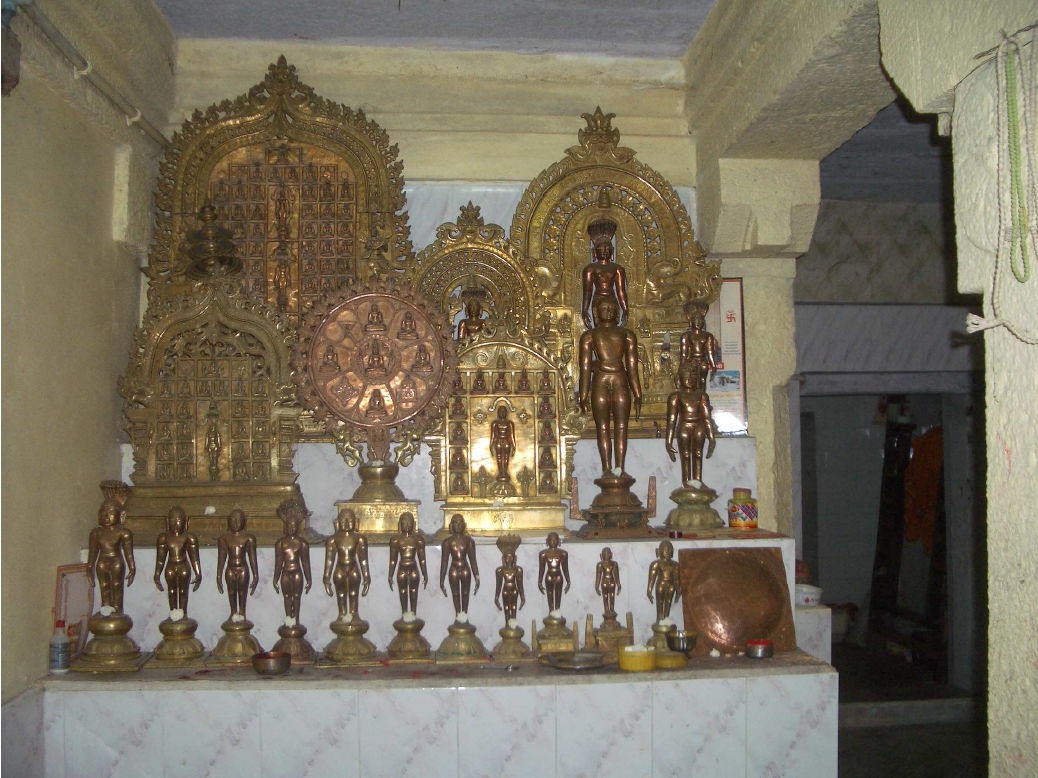
Plate 9.1
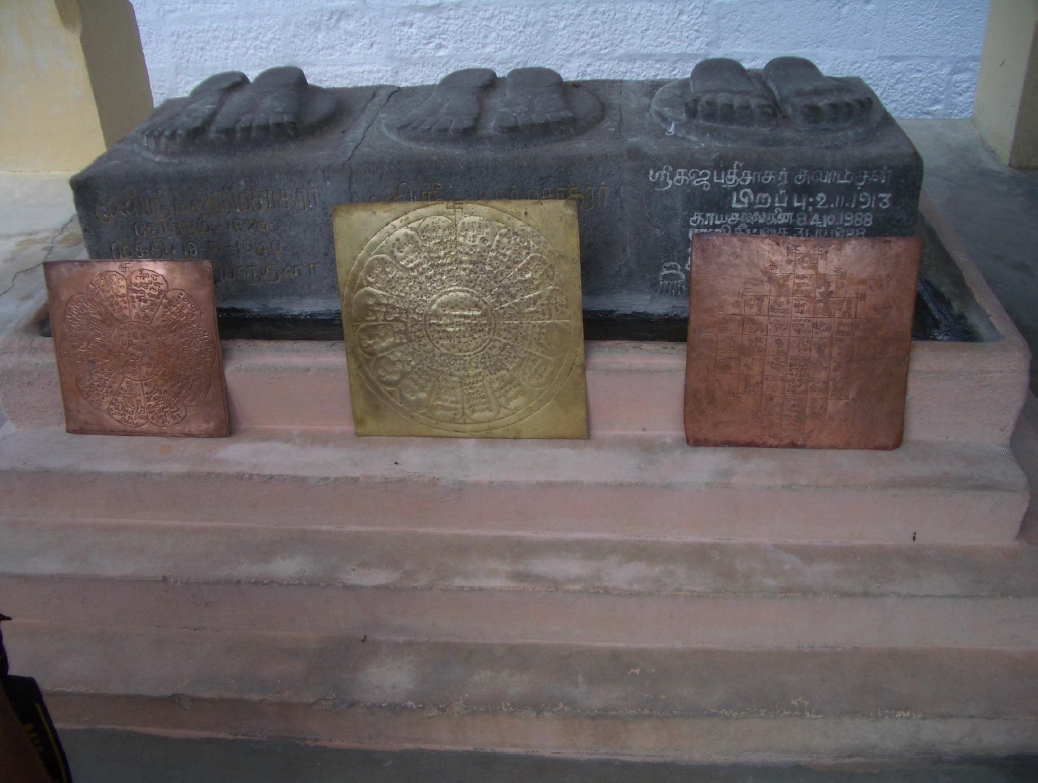
Plate 9.2
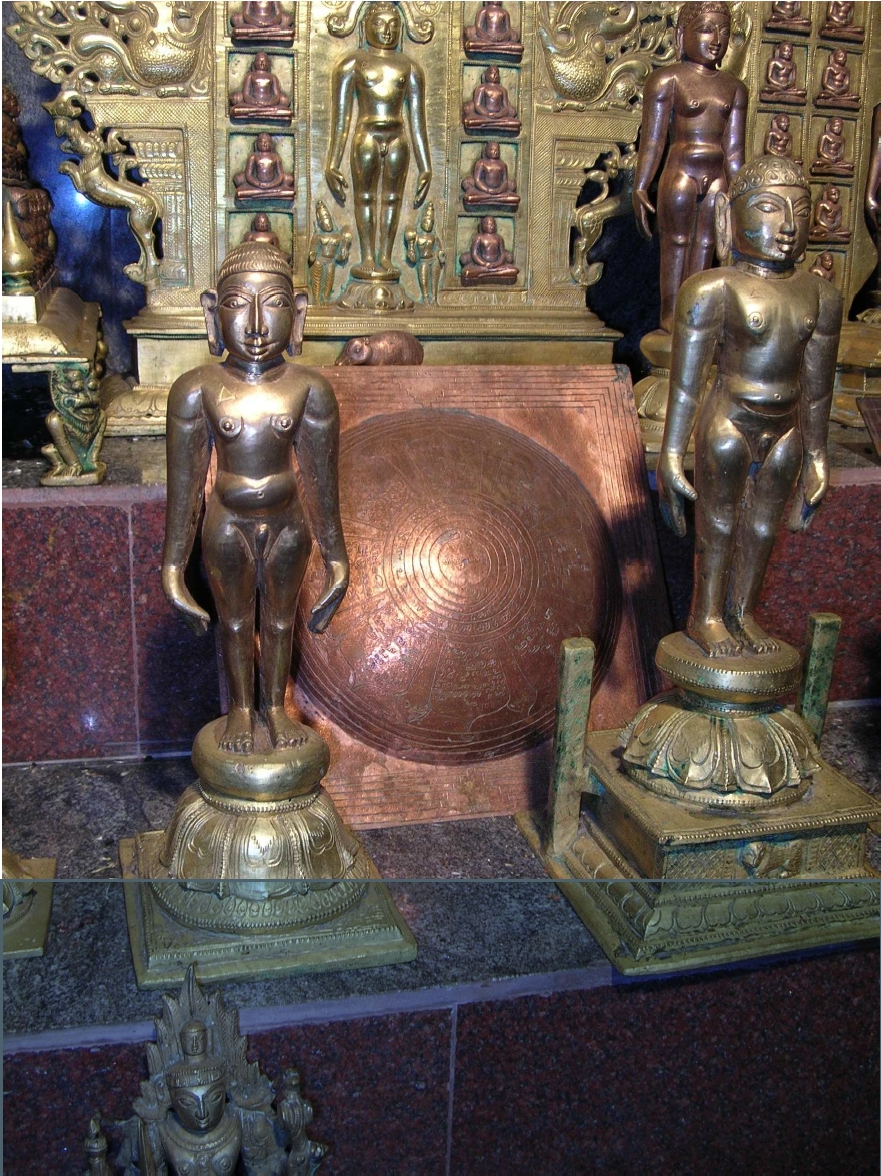
Plate 9.3
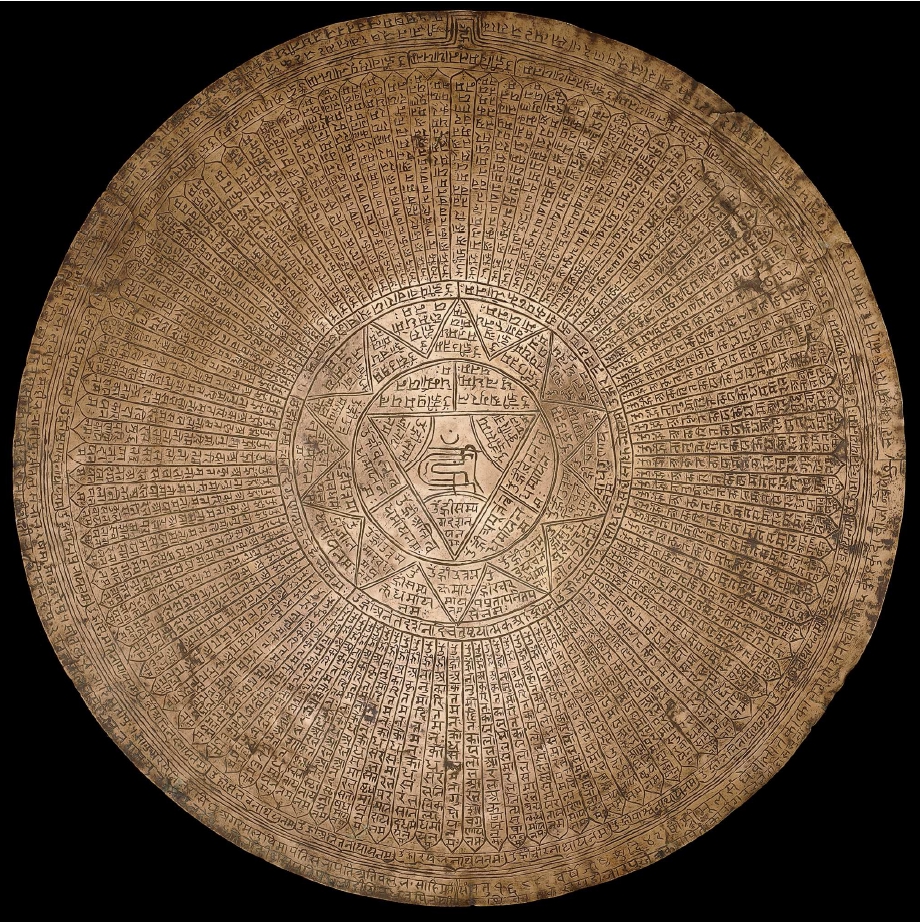
Plate 9.4
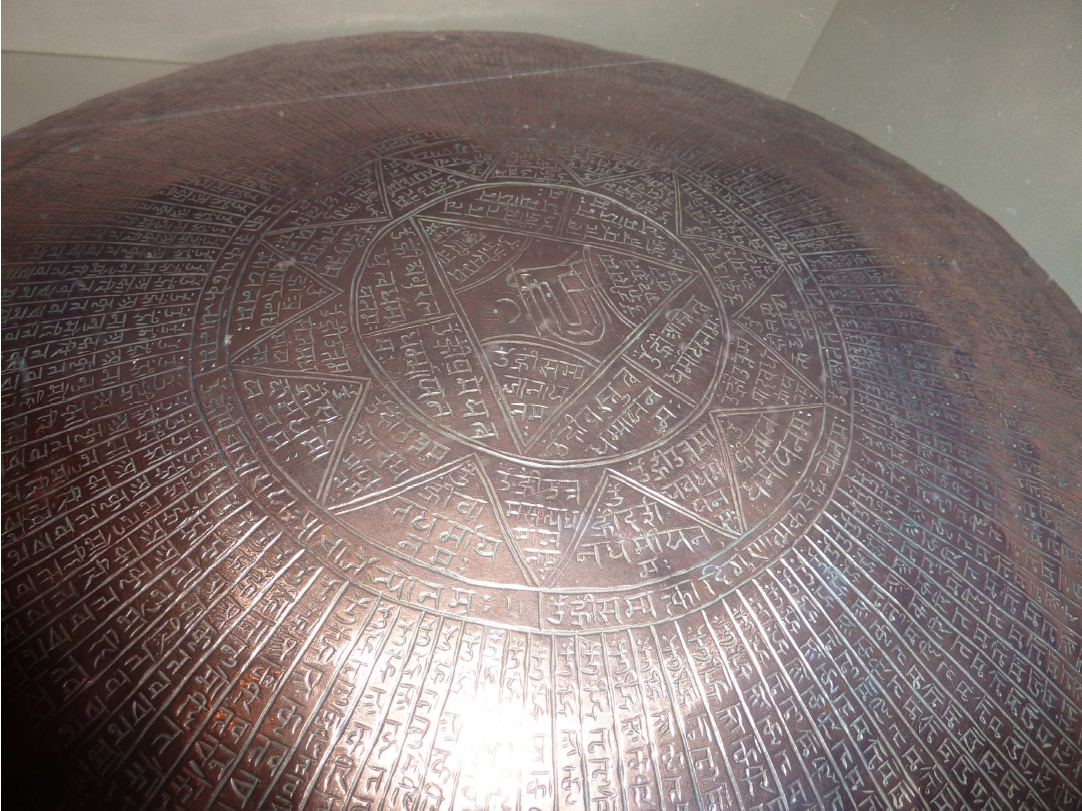
Plate 9.5
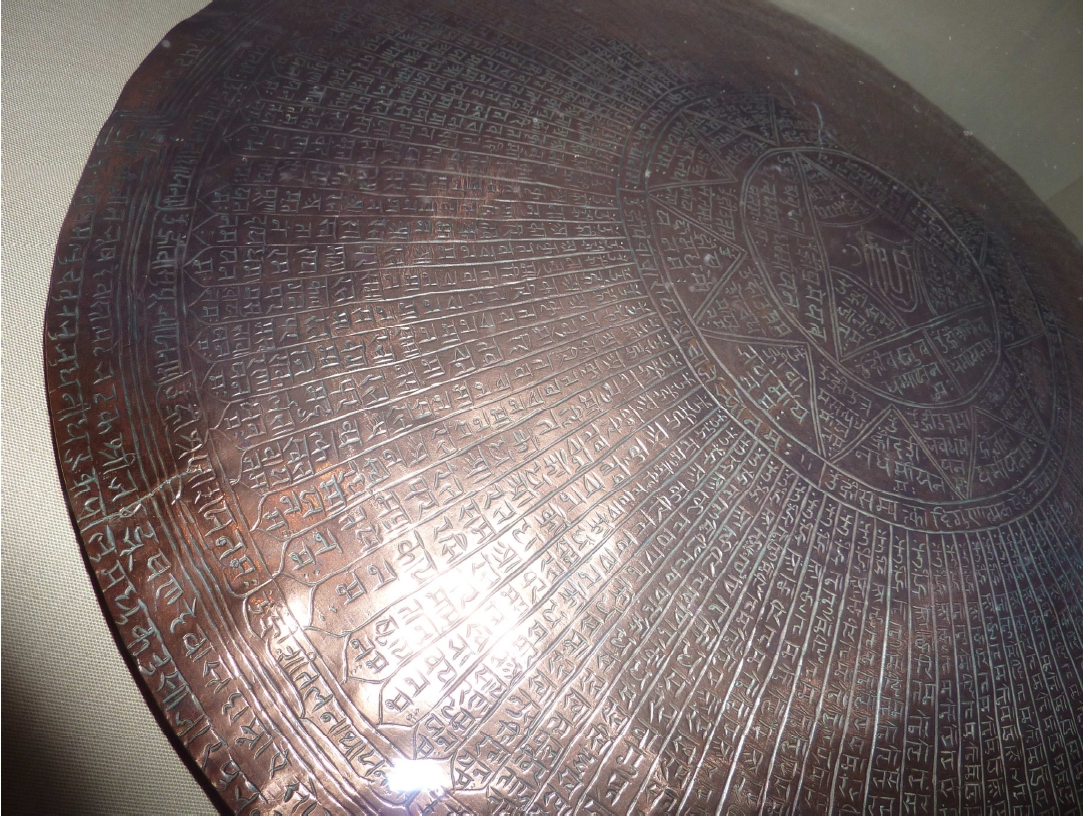
Plate 9.6
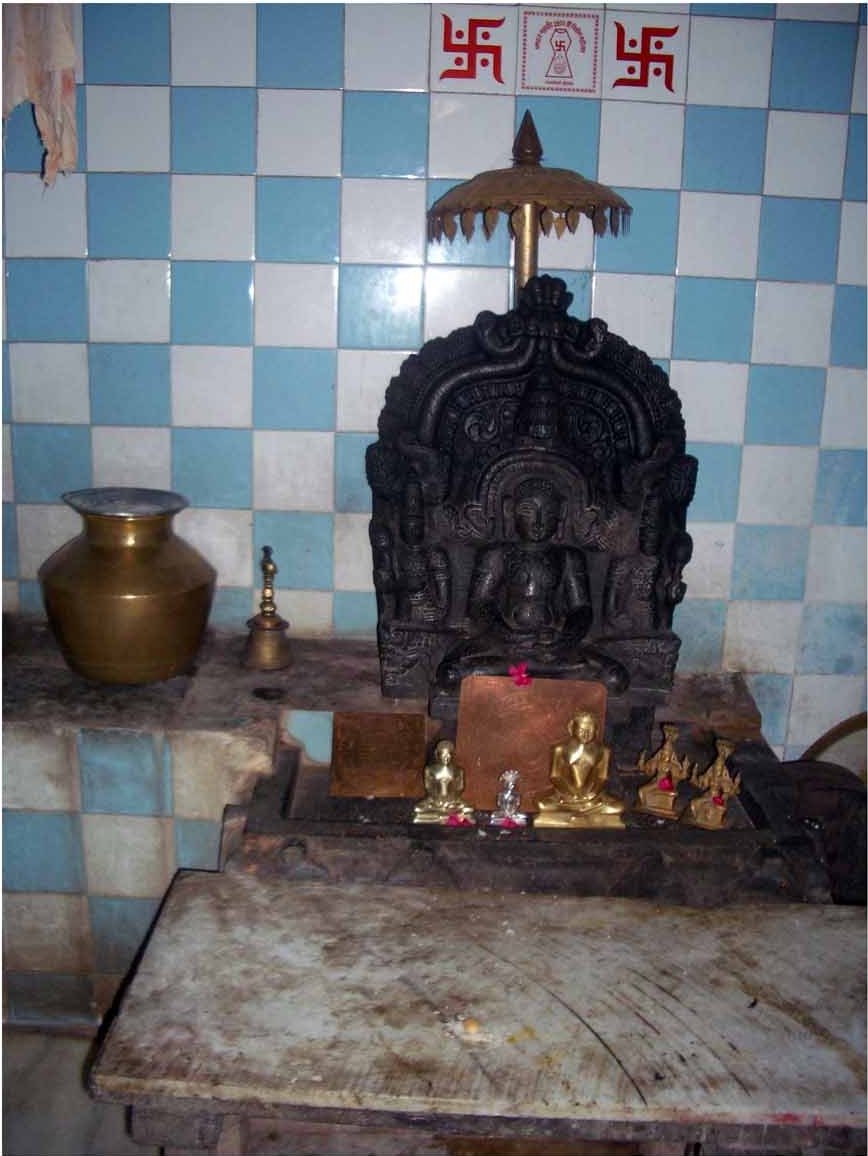
Plate 9.7
See Cort 2009: 149. This holds true in other contexts, for instance in Nepal: see A. Vergati, “Quelques remarques sur l’usage du maṇḍala et du yantra dans la vallée de Kathmandu, Népal” in Mantras et diagrammes rituels dans l’hindouisme. Editions du CNRS, Paris, 1986, pp. 37-47.
See Jain-Fischer, Part II, Plate II b: Metal Siddhacakra from the Digambara temple, Lakkundi, Karnatak.
Epigraphia Carnatica 1973: No. 488 (359) p. 524. See also Doshi 1981, plates 22a and 22b and Nagarajaiah 2007: No. 379 p. 136.
For convenience sake I quote this from Jain-Fischer 1978 II p. 4, refraining from going into more details at this stage.
Vol. 3 pp. 347-368. - I have not seen the book by Ācārya Kunthusāgar, Pratiṣṭhā Vidhi Darpaṇ (Jaipur: Śrī Digambara Jain Kunthu Vijay Granthamālā Samiti, 1992) mentioned by Cort (2009: 157 n. 37), a ritual manual for the consecration of icons where the list of required paraphernalia “includes several dozen yantras”. For Śvetāmbara yantras see, for instance, Duggaṛ 1985 with drawings, explanations, connected mantras, etc.
See, for instance, Hegewald 2009, fig. 281 “Detail of a circular metal plate incised with a sacred yantra diagram from Mandu”, and id. p. 417: “Many temples in Madhya Pradesh and Maharashtra have elongated sanctums, housing multiple Jaina images. Also in central India, it is common to find three main mūrtis or pratimās, surrounded by smaller sculptures and other religious objects. Amongst the latter one commonly finds cosmological representations and yantra discs”. - For Rajasthan see Nyāyatīrth 1990: in the first section, which is a detailed directory of Jaipur Digambara temples, the presence and number of yantras is recorded among their specific features. In the second section, 4 out of a total of 70 yantras said to be kept in the Lūṇakaraṇjī Pāṇḍyā temple (18th century) are reproduced in black and white photographs (unfortunately of a rather poor quality): one Arhaṃ yantra, one Kalikuṇḍa yantra, one with different types of yantras, and one Siddhacakra yantra which has exactly the same text as the 20th century yantra bought by Cort (see above), laid out in exactly the same way. In the fourth section, M. Bhāratīya (pp. 47-49) gives a brief description (without illustration) of some of the yantras kept in this temple. She calls them maṇḍala and ends her list with two cosmological paintings on cloth - which, however, represent a different tradition of artifacts.
Another published instance is Hegewald 2009, fig. 282, with the following comment: “Yantra discs are often placed in front of figural images to shield of evil power, as can be seen in the Neminātha temple at Tirumalai”.
Indian Archaeology 1971-72. A review, No. 13 p. 54. The inscription records the construction of a suprabhavedi by various śrāvakas who are named, and refers to “an otherwise unknown local chief Rajasimha, son of Karnesa”.
Bhaṭṭārakas often act as “caste-gurus”, but the evidence collected above for Jagadbhūṣaṇa shows that he was in contact with families of different groups. See also Mukhtar 1954: introduction p. 79 and Praśasti No. 107 p. 159 for his association with the Golāpurva caste.
See for instance Johrapurkar No. 261 (… śrīsamyagdarśana yantra karāpitaṃ pratiṣṭhāpitaṃ); 308 (śrīkalikuṇḍa yantra kārāpitaṃ / śrīkalyāṇaṃ bhūyāt); 322 (yantrapratiṣṭhā kārita tatra pratiṣṭhitam); 609 (see next note); 615 (see next note); 685 (śrībhūṣaṇa-pratiṣṭhitaṃ vīryacāritra-yantraṃ nityaṃ praṇamaṃti); 746 (see next note).
In fact very few of the yantra-inscriptions collected in Johrapurkar do record a place-name: No. 322 (Aṭerapure); No. 609 (daśalakṣaṇīyantraṃ pratiṣṭhāpitaṃ Phatehapura-madhye); No. 746 (śrī Abaḍanagara pratiṣṭhitaṃ).
For a pioneering study of bronzes found in the area and made in large numbers between the 13th and the 15th century see Jain (2007).
According to the list given in Sangave 1981: 97. Celebrations in the 17th century took place in 1612, 1659 and 1677.
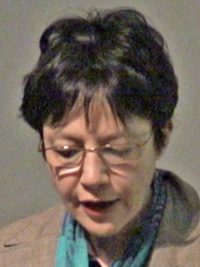 Prof. Dr. Nalini Balbir
Prof. Dr. Nalini Balbir
